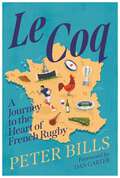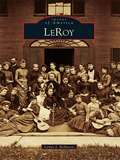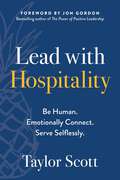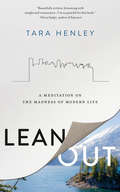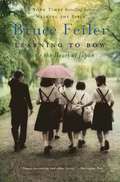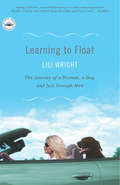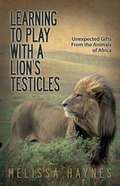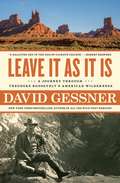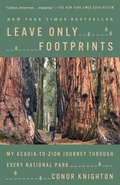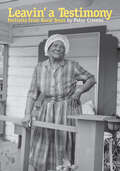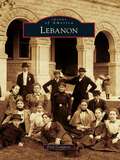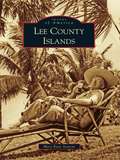- Table View
- List View
Le Coq: A Journey to the Heart of French Rugby
by Peter BillsFrom French rugby's origins in Le Havre, (as an English export in the late nineteenth century) to the Catalan coast, acclaimed rugby writer Peter Bills travels the length and breadth of this vast country visiting not only the big cities but those regional heartlands of the game such as Toulouse, Bordeaux and Clermont as well as clubs in the Basque country, to reveal a country whose deep love of rugby has created a culture and playing style like no other. Featuring exclusive interviews with many of the greatest international players to have played club rugby in France, from Jonny Wilkinson to Dan Carter, as well as French legends of the sport, from Serge Blanco and Jean-Pierre Rives to Antoine Dupont, Le Coq: A History of French rugby brings to life the passion, colour, excitement, characters, anecdotes, locations and great moments of French rugby's near 150 years of existence, just as it prepares to host the 2023 Rugby World Cup.Former French Grand Slam captain Jacques Fouroux talked of 'Rugby; the game, the life': this book will show you exactly what he meant.
Le avventure di Tamarita Rachel
by Andrea Gardiner Valeria IacobelliRecensioni del libro di Andrea Gardiner: "Quello che traspare è la determinazione di Andrea di fare la differenza". Life and Work Magazine Feb 2013. "Non è facile mettere giù questo libro... È il racconto affascinante e avvincente di una vera amante delle avventure". Jeff Lucas, autore, speaker e giornalista radiofonico. "É un libro stupefacente, che vorrei invitare chiunque abbia un cuore a leggere... Impossibile smettere di leggere una volta che si è cominciato". Woman Alive Bookclub. Recensioni del libro "Le avventure di Tamarita Rachel": "Andrea è un medico missionario in Ecuador. I bambini ameranno le avventure descritte nel suo libro, ma impareranno contemporaneamente com'è diversa la vita per i bambini nei Paesi più poveri del mondo. È un'introduzione ben realizzata che illustra i problemi di questi bambini per sensibilizzare sul tema delle adozioni a distanza". Jennifer Rees Larcombe, autrice e speaker.
Le guide ultime du camping: Liste de contrôle complète du matériel et guide des accessoires par John Johnson
by John JohnsonLe guide ultime du camping : Liste de contrôle complète du matériel et guide des accessoires par John Johnson Découvrez comment vous débuter, tout ce que vous devez savoir sur ce sport et comment camper comme un pro. Le guide ultime du camping : liste de contrôle complète du matériel et guide des accessoires Vous souhaitez vous lancer dans le camping ? Vous voulez apprendre à camper comme les pros ?¤ Si vous avez répondu oui à ces questions, ce livre est pour vous. Découvrez comment vous débuter, tout ce que vous devez savoir sur ce sport et comment camper comme un pro. L'utilisation de ces techniques et conseils de camping vous aidera à vous lancer et à camper mieux que jamais ! Découvrez les secrets que les professionnels utilisent pour s’adapter aux terrains les plus difficiles ! Avec des décennies de stratégies testées, ce livre électronique vous montrera la façon la plus rapide et la plus efficace d'apprendre ce sport ! Sont inclus : - Pour commencer. - Liste de contrôle. - Quel matériel utiliser. - Comment camper. - Préparation. + ET BIEN PLUS ENCORE ! Si vous voulez être plus fort et plus efficace au camping, alors ce guide est pour vous. --> Faites défiler jusqu'en haut de la page et cliquez sur ajouter au panier pour acheter instantanément
LeRoy (Images of America)
by Lynne J. BelluscioLeRoy is best known as the "Birthplace of Jell-O," but few people know that in 1929 it had one of the finest private airports in the United States and was home to Amelia Earhart's airplane, the Friendship. In the 19th century, LeRoy was known for Igham University, one of the first colleges for women and the first to grant a four-year degree. First settled in 1797, LeRoy has produced patent medicines, salt, limestone, dynamite, plows, agricultural commodities, stoves, organs, insulators, and a myriad of other products. Located on the eastern edge of Genesee County and 30 miles southwest of Rochester, LeRoy originally depended on water power from the Oatka Creek and was soon serviced by several railroads. It was also a station on the Underground Railroad.
LeSourdsville Lake Amusement Park
by Scott E. FowlerLeSourdsville Lake, also known as Americana Amusement Park by a generation of visitors, was a popular recreational park for many decades despite being located within 15 miles of Kings Island, one of the premier theme parks in the country. Emphasis on providing quality food and personalized catering enabled the park to host hundreds of annual company picnics, high school proms, and family reunions. The park's success was maintained by featuring such classic rides as the Electric Rainbow and the Whip and the Screechin' Eagle and Serpent roller coasters, while the Stardust Gardens provided quality entertainment ranging from the best of the big bands to the greatest music and television stars of the 1960s. Families visited "the Lake" as religiously as they drove the same route to work every day.
Lead with Hospitality: Be Human. Emotionally Connect. Serve Selflessly.
by Taylor ScottAcross all industries and levels of organizations, one key leadership trait inspires and motivates more than any other: hospitality. We have all encountered inspirational leaders who've helped us, taught us, encouraged us, pushed us to get outside our comfort zones, or motivated us to become the best version of ourselves. What is it about their leadership styles that inspires us to do more for our team and our personal and professional growth? Turns out, we admire these leaders for the same reasons we love our favorite hotels, resorts, restaurants, or bars: How they make us feel is essential. Members of today's workforce—especially millennials and Gen Z—are looking for inspiring environments and work that truly fulfills them. Before anyone is compelled to do anything they first must feel. Speaker, consultant, and hospitality industry veteran Taylor Scott knows that the most effective leaders approach their roles with heart, emotionally connecting with their team members before attempting to manage them. Scott draws from his two decades in leadership roles at respected hotels, resorts, and restaurants. He distills the principles of gracious hospitality, translating them into actionable leadership lessons which apply in any industry, such as: How making people feel welcome fosters loyalty and keeps workers engaged with an organization's purpose How serving people with empathy and compassion sparks workers' highest productivity How making people feel comfortable encourages exploration, curiosity, and discovery while inviting everyone to lean into their creativity How making people feel significant drives them to deliver their best work He also shares specific, practical steps you can take to put these principles into action. Scott shows how to connect, serve, engage, coach, and inspire your peers, teams, and even your own leaders. Lead with Hospitality is a call to action to connect with people on a human level which ultimately inspires teams, organizations, and companies to go to the next level.
Leading at The Edge: Leadership Lessons from the Extraordinary Saga of Shackleton's Antarctic Expedition
by Dennis Perkins Margaret Holtman Jillian MurphyDrawing on the amazing story of Shackleton and his polar exploration team&’s survival against all odds, author Dennis N. T. Perkins demonstrates the importance of a strong leader in times of adversity, uncertainty, and change.Part adventure tale and part leadership guide, Leading at the Edge uncovers what the legendary Antarctic adventure of Sir Ernest Shackleton, his ship Endurance, and his team of twenty-seven polar explorers can teach us about bringing order to chaos through true leadership.Among other skills, you&’ll learn how to:instill optimism while staying grounded in reality,step up to risks worth taking,consistently reinforce your team message,set a personal example,find things to celebrate,laugh small things off,and--even in the face of extreme temperatures, hazardous ice, scarce food, and complete isolation--never give up.This second edition of Leading at the Edge features additional lessons, new case studies of the strategies in action, tools to uncover and resolve conflicts, and expanded resources.An updated epilogue compares the leadership styles of the famous polar explorers Shackleton, Amundsen, and Scott, which transcend the one-hundred-plus years since their historic race to the South Pole to help today&’s leaders learn valuable lessons about the meaning of true success.
Leading the Blind: A Century of Guide Book Travel
by Alan SillitoeA journey into nineteenth-century travel guides to the UK, Europe, and Soviet Union as researched and written by one of England&’s most distinguished authors. In this quirky and illuminating social history, bestselling British author Alan Sillitoe culls fascinating details from Victorian-era guidebooks and travelogues in order to recount the pleasures, dangers, traps, and delights of travel in the century leading up to World War I. For instance, in Switzerland, an English officer once fell into a bears&’ den and was &“torn in pieces.&” In Paris, the outdoor seating at cafés was in &“unpleasant proximity to the gutters.&” In Germany and the Rhine, the denominations marked on coins did not necessarily indicate their value. And in Northern Italy, a traveler could look forward to a paradise of citron and myrtle, palms and cyclamen. For the armchair traveler journeying into a bygone era, Sillitoe begins with the essential practicalities relevant to any tourist: the price of passports and visas, how best to clear customs, and how many bags to pack. He includes timeless advice, such as: Board a boat on an empty stomach if you are prone to seasickness, and always break in your boots before embarking on a trip. Anachronistic recommendations abound as well: It is best to leave your servant at home, carry your milk with you when traveling to small Italian villages, and not pay children and &“donkey women&” for flowers. From convalescent hotels in the South of France to malaria-ridden marshes between Rome and Naples, and from the chaos of Sicily and southern Italy to the dazzling bullfights and rampant thieves of sunny Spain, Sillitoe guides readers through the minutiae of the Mediterranean with wit and historical insight. Then he takes an anecdote-filled road east into Greece, Egypt, the Holy Lands, Turkey, and Russia. Of course, the Grand Tour would not be complete without a thorough account of his home turf of England, with her idiosyncratic hamlets, smoke-filled skies, and working-class townsfolk in high-buckled shoes. At once a fascinating history of travel books from 1815 to 1914 and an entertaining ode to wanderlust, Leading the Blind brings to life the absurd and profound wonders of Victorian globetrotting. With simple but captivating prose, Sillitoe also shows how the way we view foreign lands can reveal a lot about what is happening at home.
Lean Out: A Meditation on the Madness of Modern Life
by Tara Henley"Beautifully written, brimming with insight and reassurance--I'm so grateful for this book." -Olivia Sudjic, author of ExposureA deeply personal and informed reflection on the modern world--and why so many feel disillusioned by it.In 2016, journalist Tara Henley was at the top of her game working in Canadian media. She had traveled the world, from Soweto to Bangkok and Borneo to Brooklyn, interviewing authors and community leaders, politicians and Hollywood celebrities. But when she started getting chest pains at her desk in the newsroom, none of that seemed to matter.The health crisis--not cardiac, it turned out, but anxiety--forced her to step off the media treadmill and examine her life and the stressful twenty-first century world around her. Henley was not alone; North America was facing an epidemic of lifestyle-related health problems. And yet, the culture was continually celebrating the elite few who thrived in the always-on work world, those who perpetually leaned in. Henley realized that if we wanted innovative solutions to the wave of burnout and stress-related illness, it was time to talk to those who had leaned out. Part memoir, part travelogue, and part investigation, Lean Out tracks Henley's journey from the heart of the connected city to the fringe communities that surround it. From early retirement enthusiasts in urban British Columbia to moneyless men in rural Ireland, Henley uncovers a parallel track in which everyday citizens are quietly dropping out of the mainstream and reclaiming their lives from overwork. Underlying these disparate movements is a rejection of consumerism, a growing appetite for social contribution, and a quest for meaningful connection in this era of extreme isolation and loneliness. As she connects the dots between anxiety and overwork, Henley confronts the biggest issues of our time.
Learning the Arts of Linguistic Survival
by Alison PhippsIn this ground-breaking contribution to the study of tourism and languages, Alison Phipps examines what happens when tourists learn to speak other languages. From ordering a coffee to following directions she argues for a new perception of the relationship between tourism and languages from one based on the acquisition of basic, functional skills to one which sustains and even strengthens intercultural dialogue. The twelve chapters comprising this book tell stories of the experience of learning and speaking tourist languages. Drawing on a range of disciplines Alison Phipps takes the reader on a journey through risk, way finding, mistakes, laughter, conversations and the imagination. She provides rich descriptions of the world of language learning which has remained invisible to mainstream studies of language education, existing as it does on the margins of educational life. She shows how tourism is shaped by the learning experiences of everyday life. Languages, she argues passionately, fundamentally change the nature of perception, dwelling and relationships to other people and the world. This book will be essential reading for all those interested in tourism studies and in modern languages education. It is a timely study, coming at time of crisis in languages, as English exerts its power as a world language and as a dominant language of tourism. Learning the Arts of Linguistic Survival: Languaging, Tourism, Life will also be of interest to anthropologists, linguists, geographers, sociologists and those studying education.
Learning to Bow
by Bruce FeilerLearning to Bow has been heralded as one of the funniest, liveliest, and most insightful books ever written about the clash of cultures between America and Japan. With warmth and candor, Bruce Feiler recounts the year he spent as a teacher in a small rural town. Beginning with a ritual outdoor bath and culminating in an all-night trek to the top of Mt. Fuji, Feiler teaches his students about American culture, while they teach him everything from how to properly address an envelope to how to date a Japanese girl.
Learning to Bow
by Bruce FeilerLearning to Bow has been heralded as one of the funniest, liveliest, and most insightful books ever written about the clash of cultures between America and Japan. With warmth and candor, Bruce Feiler recounts the year he spent as a teacher in a small rural town. Beginning with a ritual outdoor bath and culminating in an all-night trek to the top of Mt. Fuji, Feiler teaches his students about American culture, while they teach him everything from how to properly address an envelope to how to date a Japanese girl.
Learning to Float: The Journey of a Woman, a Dog, and Just Enough Men
by Lili WrightLili Wright is a thirty-something woman on the emotional lam. Faced with a choice between two men--Stuart, the steady veterinarian, and Peter, the dreamy writer--she climbs into her car and leaves them both behind.With only a borrowed dog named Brando for company and a map of twelve states in her pocket, Lili sets out on a road trip, hoping that by setting herself in motion she will find a way to settle down. Charting a course from Cadillac Mountain in Maine to the faded glory of Key West, Florida, she camps out on beaches and crashes on couches, in sketchy motels and even in a cop's trailer. She travels not only south, but also back in time, trying to figure out why previous relationships with a Nantucket waiter, a French tennis clown, a Utah ski bum, and others flared and fizzled.Along the way, Lili meets a string of unlikely gurus, including a well-worn shrimper, a vegan astrologer, and even a woman who marries herself. These and other unassuming strangers offer offbeat wisdom and guidance as Lili struggles to understand the nature of love, the voodoo of sex, and how couples can settle down without settling for. Between adventures, Lili tackles tough questions: Why does everything love touches turn risky? Does staying with the same person mean staying the same? Where does love come from, and where does it go? By journey’s end, this restless traveler begins to see how she can share her life with just one other person, and how love, like water, can make a body float.Lili Wright’s engaging memoir from the road updates the tradition of the picaresque traveler’s tale. With unflinching honesty and refreshing wit, she captures the torn emotions, comic misfires, and inevitable trade-offs felt by young people everywhere.
Learning to Play With a Lion's Testicles
by Melissa HaynesThe cheeky title of Melissa Haynes's story of adventure in Africa, Learning to Play with a Lion's Testicles, earned the book some big publicity on NBC-TV/Late Night with Jimmy Fallon on September 4,2013 where it topped the show's list of "Titles Not to Read" for September 2013. Melissa's book was also a big smash on the March 11, 2014 Ellen Show, where Ellen and guest Ricky Gervais highlighted the book throughout the entire hour. Playing with a lion's testicles: An African saying that means to take foolhardy chances.Melissa, an exhausted executive from the city seeks meaning and purpose from her work, and volunteers for a Big Five conservation project in South Africa. Her boss, an over-zealous ranger, nicknamed the Drill Sergeant, has no patience for city folk, especially if they're women, and tries to send her packing on day one. But Melissa stands her ground with grit and determination, however shaky it may be.Conflict soon sets the pace with a cast filled with predatory cats, violent elephants, and an on-going battle of wits with the Drill Sergeant. Even Mother Nature pounds the reserve with the worst storm in a century. But the most enduring and profound conflict is the internal battle going on within Melissa, as she tries to come to terms with the guilt surrounding her mother's death. When death grips the game reserve, it is the very animals Melissa has come to save that end up saving her.For the reader who has ever dreamed of going to Africa or knows the pain of loss and guilt, LEARNING TO PLAY WITH A LION'S TESTICLES will fill your soul.
Leave It As It Is: A Journey Through Theodore Roosevelt's American Wilderness
by David GessnerBestselling author David Gessner&’s wilderness road trip inspired by America&’s greatest conservationist, Theodore Roosevelt, is &“a rallying cry in the age of climate change&” (Robert Redford).&“Leave it as it is,&” Theodore Roosevelt announced while viewing the Grand Canyon for the first time. &“The ages have been at work on it and man can only mar it.&” Roosevelt&’s pronouncement signaled the beginning of an environmental fight that still wages today. To reconnect with the American wilderness and with the president who courageously protected it, acclaimed nature writer and New York Times bestselling author David Gessner embarks on a great American road trip guided by Roosevelt&’s crusading environmental legacy. Gessner travels to the Dakota badlands where Roosevelt awakened as a naturalist; to Yellowstone, Yosemite, and the Grand Canyon where Roosevelt escaped during the grind of his reelection tour; and finally, to Bears Ears, Utah, a monument proposed by Native Tribes that is currently embroiled in a national conservation fight. Along the way, Gessner questions and reimagines Roosevelt&’s vision for today&’s lands. &“Insightful, observant, and wry,&” (BookPage) Leave It As It Is offers an arresting history of Roosevelt&’s pioneering conservationism, a powerful call to arms, and a profound meditation on our environmental future.
Leave No Trace in the Outdoors
by Jeffrey L. MarionThe essential guide for enjoying the outdoors without harming the environment. <p><p>• Details the seven core principles of Leave No Trace ethics and practices <p>• Covers hiking, campfires, food storage, and personal hygiene <p>• Endorsed by the USDI National Park Service, Bureau of Land Management, Fish and Wildlife Service, U.S. Geological Survey, and the USDA Forest Service
Leave Only Footprints: My Acadia-to-Zion Journey Through Every National Park
by Conor Knighton<P><P>From CBS Sunday Morning correspondent Conor Knighton, a behind-the-scenery look at his year traveling to each of America's National Parks, discovering the most beautiful places and most interesting people our country has to offerWhen Conor Knighton set off to explore America's "best idea," he worried the whole thing could end up being his worst idea. <P><P>A broken engagement and a broken heart had left him longing for a change of scenery, but the plan he'd cooked up in response had gone a bit overboard in that department: Over the course of a single year, Knighton would visit every national park in the country, from Acadia to Zion. In Leave Only Footprints, Knighton shares informative and entertaining dispatches from what turned out to be the road trip of a lifetime. Whether he's waking up early for a naked scrub in a historic bathhouse in Arkansas or staying up late to stargaze along our loneliest highway in Nevada, Knighton weaves together the type of stories you're not likely to find in any guidebook. <P><P>Through his unique lens, America the Beautiful becomes America the Captivating, the Hilarious, and the Inspiring. Along the way, he identifies the threads that tie these wildly different places together—and that tie us to nature—and reveals how his trip ended up changing his views on everything from God and love to politics and technology. Filled with fascinating tidbits about our parks' past and reflections on their fragile future, this book is both a celebration of and a passionate case for the natural wonders that all Americans share. <P><P><b>A New York Times Bestseller</b>
Leave the Lipstick, Take the Iguana
by Marcy GordonLeave the Lipstick, Take the Iguanais the ninth book in the best-selling Travelers' Tales humor series, which began withThere's No Toilet Paper on the Road Less Traveledand blossomed into the now classic "underwear" women's humor series, including the top sellersSand in My BraandMore Sand in My Bra. This laugh-out-loud collection will resonate with experienced travelers and novices alike and includes hilarious misadventures with packing, travel fashion, border crossings, language faux pas, weird encounters with exotic cuisine, and romantic overtures abroad.
Leavenworth
by Rose Kinney-Holck Upper Valley Museum at LeavenworthLeavenworth, located in the central Cascades of Washington state, was once known as Icicle, and has been home to Native Americans, settlers, miners, railroad workers, and loggers. The native tribes came to this pristine and bountiful area to hunt game and fish for salmon. The promise of gold brought miners to Leavenworth, and once the Great Northern Railroad laid down its tracks in the late 1800s, the town moved from Icicle to its present location. The Lamb-Davis Lumber Company also built a sawmill in town, but when the railroad relocated its tracks and moved its hub to Wenatchee, the sawmill closed in 1926. The little boomtown in the Cascades went bust, but it was reinvented by its residents in the early 1960s with a Bavarian theme. The Bavarian premise of Leavenworth is still intact, and today the city draws around 2.5 million visitors annually.
Leaves from a Russian Diary—and Thirty Years After [Enlarged Edition]
by Pitirim A. SorokinThe reminiscences of a fiercely anti-Communist Petrograd professor, Pitirim A. Sorokin—from the February Revolution right through to his departure from Russia in September 1922.This is the enlarged edition published almost 30 years after the first 1924 publication and contains the additional section, “Thirty Years After,” in which the author describes how the Revolution that has since come of age has turned out to be simultaneously “a gigantic success and a colossal failure.”A fascinating read.
Leavin' a Testimony: Portraits from Rural Texas (Focus on American History Series)
by Patsy CravensFirst settled by Stephen F. Austin's colonists in the early nineteenth century, Colorado County has deep roots in Texas history. Mainly rural and agrarian until late in the twentieth century, Colorado County was a cotton-growing region whose population was about evenly divided between blacks and whites. These life-long neighbors led separate and unequal lives, memories of which still linger today. To preserve those memories, Patsy Cravens began interviewing and photographing the older residents of Colorado County in the 1980s. In this book, she presents photographs and recollections of the last generation, black and white, who grew up in the era of Jim Crow segregation. The folks in Colorado County have engrossing stories to tell. They recall grinding poverty and rollicking fun in the Great Depression, losing crops and livestock to floods, working for the WPA, romances gone wrong and love gone right, dirty dancing, church and faith, sharecropping, quilting, raising children, racism and bigotry, and even the horrific lynching of two African American teenagers in 1935. The Colorado County residents' stories reveal an amazing resiliency and generosity of spirit, despite the hardships that have filled most of their lives. They also capture a rural way of life that was once common across the South, but is now gone forever.
Leaving Good Things Behind: Photographs of Atlantic Canada
by Darren CalabreseWhen a family tragedy pulled photojournalist Darren Calabrese back to Atlantic Canada, the region both he and his wife once called home, he was confronted with a sense of profound grief. But, on returning to the rural property where he grew up, as a new father, he rediscovered an appreciation for the geographies, histories, and people of New Brunswick, Nova Scotia, Prince Edward Island, and Newfoundland and Labrador, turning his lens to explore the tension between the perseverance of tradition and the inevitability of change.Darren&’s work led him into communities across the eastern provinces, who welcomed him to document the inextricable relationship between people, their stories, and the landscapes—equally beautiful and harsh—where they live and work. The result is an astonishing, evocative collection of curated photographs and archival images, with personal essays on family, coming home, loss, and his experiences exploring the region woven in throughout.Elegant, spare, and revelatory at every turn, Leaving Good Things Behind shines a light on both the challenges and joys of the places we live.
Lebanon
by Fred ComptonFounded in 1802, Lebanon, Ohio, was once dubbed by noted author and broadcaster Charles Kurault as the most historic spot in the state. Home to Ohio's oldest business, the iconic Golden Lamb, and the oldest weekly newspaper west of the Allegheny Mountains, the Western Star, Lebanon has sat quietly by the side of the road for over two centuries and waited while the world came to it. Located midway on the main stage route between Cincinnati and Dayton, Lebanon was a natural stopping point for travelers throughout the 19th and early 20th centuries, including 12 U.S. presidents and numerous authors and dignitaries who would help mold America's future. Along the way, Lebanon was home to one of the earliest coeducational teachers colleges, National Normal University, and the largest Shaker community in the west, Union Village. The men and the monuments are all gone now, but the city, rich in history and heritage, remains.
Lebanon
by Historic Lebanon Kim Jackson ParksFounded in 1802 and named for the biblical land of cedars, Lebanon has been a center for commerce, education, and culture for over 200 years. The rich histories of Cumberland University, Cumberland School of Law, and Castle Heights Military Academy are intertwined with the city. Cumberland University served as Director Headquarters for the Tennessee Maneuvers of the Second Army during World War II. Politicians such as Sam Houston, William Jennings Bryan, and Frank Clement all used the Lebanon Square as a public forum. In fact, Sam Houston began his law career here in 1818. Known as the wool capital of Tennessee for many years, Lebanon was home to the Lebanon Woolen Mills for nearly a century. This strong business tradition continues today. Cracker Barrel Old Country Store, founded here in 1969, maintains its national headquarters in the city.
Lee County Islands
by Mary Kaye StevensWhen Ponce de Leon visited Southwest Florida in 1513, he discovered some of North America's most pristine tropical islands. Yet it was here where the explorer met his death at the hands of Calusa Indians who had made their home on the islands since 500 bc. Remaining relatively isolated from mainland society until the mid-1900s, the islands were home to a few hardscrabble pioneers who endured stifling heat, swarming mosquitoes, and deadly storms. Famous anglers such as Thomas Edison, Zane Grey, and Teddy Roosevelt enjoyed stalking the elusive tarpon in this sports fishing paradise. Likewise, the pervasive solitude inspired writers, including Edna St. Vincent Millay, Mary Roberts Rinehart, and Richard Powell. Home to some of the world's best beaches, it is not surprising visitors and residents find the lifestyles and histories of Lee County's quaint islands worth preserving.
